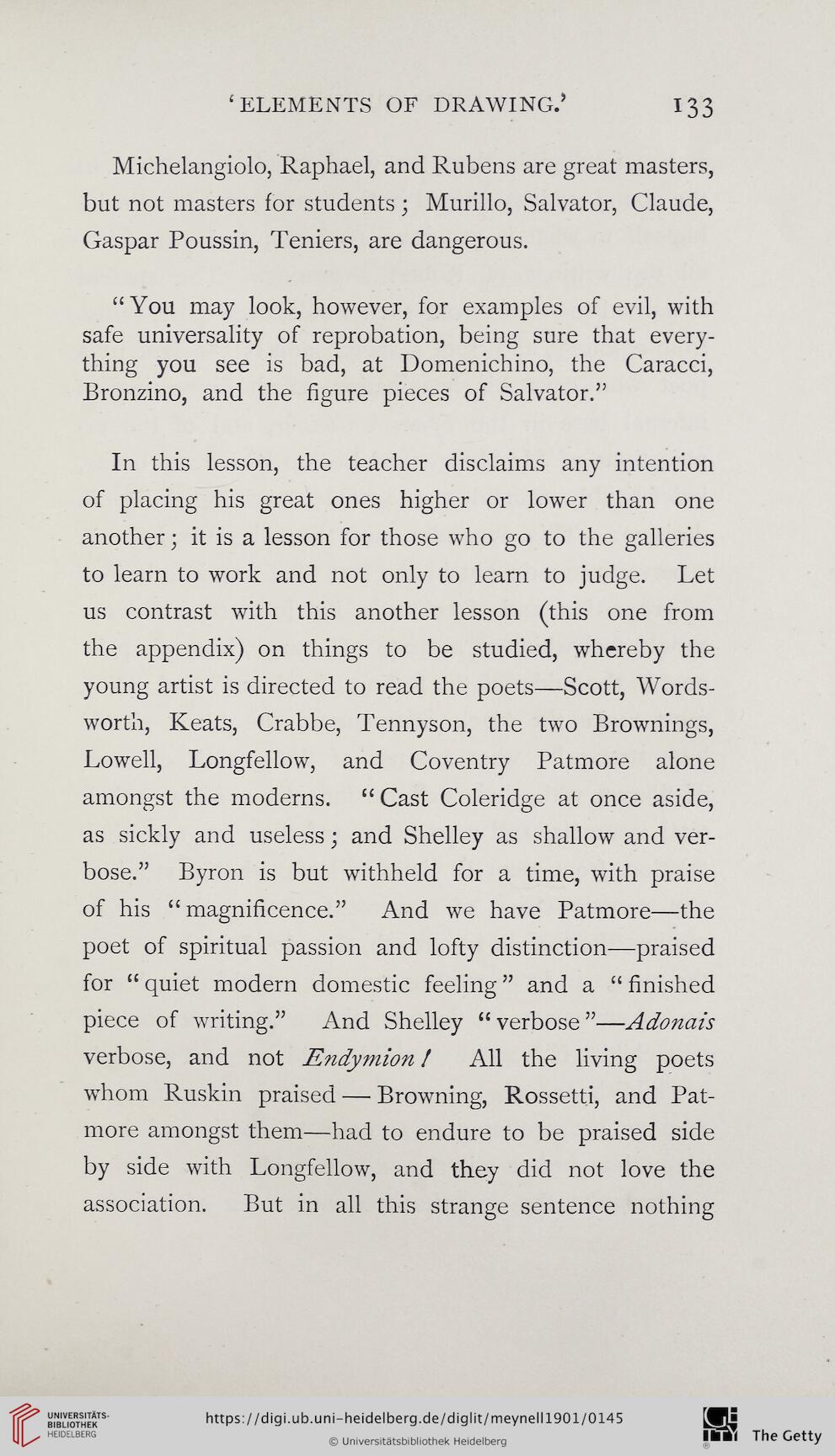‘ELEMENTS OF DRAWING.’ 133
Michelangiolo, Raphael, and Rubens are great masters,
but not masters for students; Murillo, Salvator, Claude,
Gaspar Poussin, Teniers, are dangerous.
“You may look, however, for examples of evil, with
safe universality of reprobation, being sure that every-
thing you see is bad, at Domenichino, the Caracci,
Bronzino, and the figure pieces of Salvator.”
In this lesson, the teacher disclaims any intention
of placing his great ones higher or lower than one
another; it is a lesson for those who go to the galleries
to learn to work and not only to learn to judge. Let
us contrast with this another lesson (this one from
the appendix) on things to be studied, whereby the
young artist is directed to read the poets—Scott, Words-
worth, Keats, Crabbe, Tennyson, the two Brownings,
Lowell, Longfellow, and Coventry Patmore alone
amongst the moderns. “ Cast Coleridge at once aside,
as sickly and uselessj and Shelley as shallow and ver-
bose.” Byron is but withheld for a time, with praise
of his “magnificence.” And we have Patmore—the
poet of spiritual passion and lofty distinction—praised
for “ quiet modern domestic feeling ” and a “ finished
piece of writing.” And Shelley “ verbose ”—Adonais
verbose, and not Endymion! All the living poets
whom Ruskin praised — Browning, Rossetti, and Pat-
more amongst them—had to endure to be praised side
by side with Longfellow, and they did not love the
association. But in all this strange sentence nothing
Michelangiolo, Raphael, and Rubens are great masters,
but not masters for students; Murillo, Salvator, Claude,
Gaspar Poussin, Teniers, are dangerous.
“You may look, however, for examples of evil, with
safe universality of reprobation, being sure that every-
thing you see is bad, at Domenichino, the Caracci,
Bronzino, and the figure pieces of Salvator.”
In this lesson, the teacher disclaims any intention
of placing his great ones higher or lower than one
another; it is a lesson for those who go to the galleries
to learn to work and not only to learn to judge. Let
us contrast with this another lesson (this one from
the appendix) on things to be studied, whereby the
young artist is directed to read the poets—Scott, Words-
worth, Keats, Crabbe, Tennyson, the two Brownings,
Lowell, Longfellow, and Coventry Patmore alone
amongst the moderns. “ Cast Coleridge at once aside,
as sickly and uselessj and Shelley as shallow and ver-
bose.” Byron is but withheld for a time, with praise
of his “magnificence.” And we have Patmore—the
poet of spiritual passion and lofty distinction—praised
for “ quiet modern domestic feeling ” and a “ finished
piece of writing.” And Shelley “ verbose ”—Adonais
verbose, and not Endymion! All the living poets
whom Ruskin praised — Browning, Rossetti, and Pat-
more amongst them—had to endure to be praised side
by side with Longfellow, and they did not love the
association. But in all this strange sentence nothing




